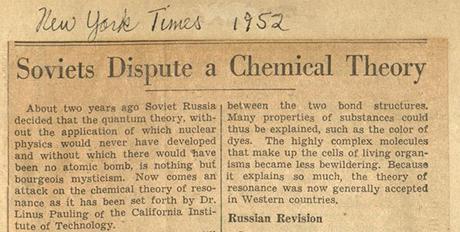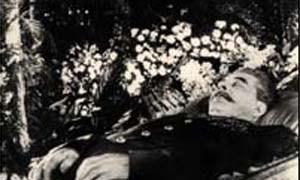Posted on by scarc

Beginning in the late 1940s, Linus Pauling's theory of resonance came under attack in the Soviet Union, first by scientists and then by the Soviet state itself. The primary points of contention for Pauling's Soviet critics hinged on the seeming abstractness of his theory as well as his failure to acknowledge Russian and Soviet scientists deemed important to the development of his ideas. The more they considered the theory, the more their contempt grew, to the point where Soviet chemists were eventually called upon to lead an "army of many thousands strong" against Pauling. These sentiments did not reach Pauling until 1951, a full two years after the debate within the Soviet Union began. Though surprised by the tone of the Soviets complaints, Pauling did not stand down and instead launched a counter-offensive of his own in support of his scientific work.
Pauling became aware of the brewing controversy in August 1951, when a translated article from the Soviet scientific literature was sent to his office. In response, Pauling wrote a charged letter to the Soviet Academy of Sciences condemning the piece and upholding the importance of resonance theory as key to growth in the field of structural chemistry. In the letter, Pauling made clear his belief that the critics' rhetoric was falsely placed and, indeed, that "the attempted suppression of a part of science is based upon a faulty conception of the nature of science."
Pauling took particular objection to the ideological arguments against his theory, finding them baseless since they did not intersect at all with the scientific principles that informed his theory. He also warned of the dangers of refusing to incorporate resonance into an entire nation's scientific vernacular, judging that "Any chemist in the modern world who attempts to carry on his work without making use of the theory of resonance [...] is seriously handicapped."
At the conclusion of the letter, Pauling took pains to praise the two Soviet scientists, Ia. K. Syrkin and M.E. Diatkina, who had translated his work, had spread word of his theory among their colleagues, and who had ultimately been forced to recant their support. In Pauling's view, the duo were "among the most able chemists in the USSR."
Pauling's reply was met with scorn in the Soviet Union, and as a direct result of the letter, the Soviet Academy organized a special meeting to specifically discuss and condemn resonance theory. Held at the end of 1951, the meeting was attended by over 400 people and featured public denunciations of Pauling's work by no fewer than forty-four prominent Soviet scientists.
One especially notable speaker was Ia. K. Syrkin, the erstwhile translator of Pauling's Nature of the Chemical Bond. In his presentation, Syrkin introduced his remarks by suggesting that Pauling's
substitution of the real molecule by a set of resonance structures for the sake of convenience led to an arbitrary and speculative element, and brought about what looks like an explanation, instead of an actual critical analysis and discussion of the mechanism of chemical reactions.
While it is unclear if this notion represented Syrkin's true feelings, it is reasonable to presume that his words echoed the sentiments of many in attendance. As he moved forward through his talk, Syrkin put forth a standard criticism of resonance objecting to the notion that a molecule might not have a discrete structure. This argument, of course, was grounded fully in Soviet ideology, and specifically the belief that everything must be real and known.
 Joseph Stalin lying in state
Joseph Stalin lying in state As it turned out, Pauling's letter and the Soviet Academy meeting that followed marked the crescendo of the resonance theory controversy. Following the conclusion of the 1951 conference the debate continued to simmer, with small attacks volleyed by both sides for another two years. But in 1953, curiously, the controversy came to an end, specifically because of the death of Soviet Premier Joseph Stalin.
The end if Stalin's reign ushered in a new era for the Soviets, one where it was no longer imperative to uphold orthodoxy for fear of severe punishment, including death. And the fact that the Soviet scientific community did not pursue its condemnation of resonance theory with any vigor following Stalin's demise suggests that the debate was never actually rooted in beliefs about problems with the science of resonance. More likely, resonance was just one of many convenient targets for Stalin and other Soviet figureheads in their war against ideas that were ideologically incongruent with Soviet doctrine.
Whatever the case, after 1953 the resonance controversy was effectively concluded, though a few actions remained to be taken by both parties involved. These activities, as well as the western scientific world's take on the dispute, will be the focus of our final two posts in this series.
Filed under: Nature of the Chemical Bond | Tagged: Ia. K. Syrkin, Linus Pauling, resonance theory, Soviet Academy of Sciences, Soviet Union |
